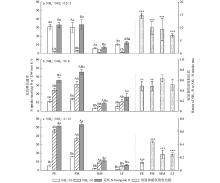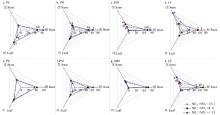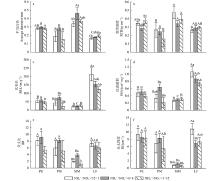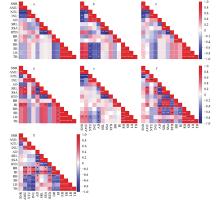

Scientia Silvae Sinicae ›› 2023, Vol. 59 ›› Issue (2): 48-57.doi: 10.11707/j.1001-7488.LYKX20220073
• • Previous Articles Next Articles
Qianyuan Liu1( ),Yifan Chen3,Yanmei Chen1,Huimin Wang2,*
),Yifan Chen3,Yanmei Chen1,Huimin Wang2,*
Received:2022-02-10
Online:2023-02-25
Published:2023-04-27
Contact:
Huimin Wang
E-mail:liuqianyuan333@126.com
CLC Number:
Qianyuan Liu,Yifan Chen,Yanmei Chen,Huimin Wang. Effects of Different Ammonium to Nitrate Ratios on Nitrogen Uptake Preference and Traits of Absorptive Roots of Subtropical Trees Seedlings[J]. Scientia Silvae Sinicae, 2023, 59(2): 48-57.
Table 1
The height and ground diameter of plants in the initial stage"
| 铵硝比NH4+∶NO3? | 高度Height /cm | 地径Ground diameter /mm | |
| 湿地松Pinus elliottii | 15∶1 | 23.06±1.30 | 4.81±0.18 |
| 8∶8 | 22.75±1.16 | 4.51±0.17 | |
| 1∶15 | 21.00±0.53 | 4.61±0.12 | |
| 马尾松 Pinus massoniana | 15∶1 | 26.88±1.37 | 3.45±0.12 |
| 8∶8 | 26.88±2.02 | 3.47±0.26 | |
| 1∶15 | 23.00±1.65 | 3.13±0.14 | |
| 深山含笑Michelia maudiae | 15∶1 | 72.19±3.48 | 6.65±0.34 |
| 8∶8 | 75.31±3.57 | 7.17±0.13 | |
| 1∶15 | 68.60±3.91 | 7.28±0.33 | |
| 枫香Liquidambar formosana | 15∶1 | 75.33±3.22 | 5.35±0.26 |
| 8∶8 | 83.08±3.64 | 5.06±0.16 | |
| 1∶15 | 80.20±1.66 | 5.79±0.29 |
Table 2
Multi-way analysis of variance (ANOVA) to test the effects of tree species, NH4+/NO3?, and N form on N uptake rates by plants"
| 因素 Factors | 平均值 Mean Square | 自由度 Df | F 值 F value | P 值 P value |
| 树种 Tree species | 2040.94 | 3 | 136.05 | < 0.001 |
| 铵硝比 NH4+/NO3? | 169.29 | 2 | 11.29 | < 0.001 |
| 氮形态 N form | 250.62 | 1 | 16.71 | < 0.001 |
| 树种×铵硝比 Tree species × NH4+/NO3? | 96.98 | 6 | 6.47 | < 0.001 |
| 树种×氮形态 Tree species × N form | 73.44 | 3 | 4.90 | 0.004 |
| 铵硝比×氮形态 NH4+/NO3? × N form | 2785.03 | 2 | 185.65 | < 0.001 |
| 树种×铵硝比×氮形态 Tree species × NH4+/NO3? × N form | 432.43 | 6 | 28.83 | < 0.001 |
| 误差 Error | 15.00 | 72 |

Fig.1
NH4+-N and NO3?- N uptake rates and their ratios of different plants in substrates with different NH4+/NO3? PE means Pinus elliottii, PM means Pinus massoniana, MM means Michelia maudiae, and LF means Liquidambar formosana. The same below. Lowercase letters represent significant differences of uptake rates for different N forms by the same species, and uppercase letters represent significant differences among three ratios of ammonium to nitrate in the same species. Asterisk represents significant: *** means P < 0.001, ** means P < 0.01, * means P < 0.05."


Fig.2
The percent of N uptake amount in root, stem, and root to total N uptake amount (%) Pictures with a-d were the percent of ammonium nitrogen absorbed by plants in each organ, while e-h mean the percent of nitrate nitrogen. Lowercase letters indicate the significant difference between three ratios of ammonium to nitrate in the same organ, and unmarked letters mean no significant differences."

Table 3
Two-way analysis of variance (ANOVA) to test the effects of tree species and NH4+/NO3? on traits of plant absorptive roots"
| P值 P value因素 Factor | 直径Diameter | 比根长Specific root length | 比表面积Specific surface area | 组织密度Root tissue density | 分支比Branching ratio | 分支强度 Branching intensity |
| 铵硝比 NH4+/NO3? | 0.68 | 0.023 | 0.022 | 0.463 | 0.053 | 0.410 |
| 树种 Tree species | < 0.001 | < 0.001 | < 0.001 | 0.001 | < 0.001 | < 0.001 |
| 树种×铵硝比 Tree species × NH4+/NO3? | 0.515 | 0.030 | 0.045 | 0.429 | 0.905 | 0.708 |

Fig.3
The functional traits of plant absorptive roots with different NH4+/NO3? Lowercase letters represent significant differences among three ratios of ammonium to nitrate of the same species, uppercase letters represent significant differences among four tree species, and unmarked letters mean no significant differences."


Fig.4
The Pearson correlation plot of biomass, N uptake rate, morphological and architectural traits of absorptive roots and substrate NH4+/NO3? a. Pinus elliottii; b. Pinus massoniana; c. Michelia maudiae; d. Liquidambar formosana; e. Coniferous species; f. Broad-leaved species; g. All species. SNR represents the ratio of substrate ammonium nitrogen to nitrate nitrogen, AMU represents uptake rate of ammonium nitrogen, NTU represents uptake rate of nitrate nitrogen, INU represents uptake rate of inorganic nitrogen, AD represents average diameter of absorptive root, SRL represents specific root length, SSA represents specific surface area of absorptive root, RTD represents density of root tissue, BR represents branching ratio, BI represents branching intensity, RB represents root biomass, SB represents the stem biomass, LB represents leaf biomass and TB represents the total plant biomass. *** means P < 0.001, ** means P < 0.01, and * means P < 0.05."

| 丁 宁, 陈 倩, 许海港, 等 施肥深度对矮化苹果15 N-尿素吸收、利用及损失的影响 . 应用生态学报, 2015, 26 (3): 755- 760. | |
| Ding N, Chen Q, Xu H G, et al Effect of fertilization depth on 15N-urea absorption, utilization and loss in dwarf apple trees . Chinese Journal of Applied Ecology, 2015, 26 (3): 755- 760. | |
| 国家林业和草原局. 2020. 2014-2018中国森林资源报告. 中国林业出版社. | |
| National Forestry and Grassland Administration of China. 2020. China forest resources report of 2014-2018. China Forestry Publishing House. [in Chinese] | |
|
乔云发, 苗淑杰, 韩晓增 氮素形态对大豆根系形态性状及释放H+的影响. 大豆科学, 2006, 25 (3): 265- 269.
doi: 10.3969/j.issn.1000-9841.2006.03.012 |
|
|
Qiao Y, Miao S, Han X Effects of nitrogen forms on the root morphology and proton extrusion in soybean. Soybean Science, 2006, 25 (3): 265- 269.
doi: 10.3969/j.issn.1000-9841.2006.03.012 |
|
|
陶 爽, 华晓雨, 王英男, 等 不同氮素形态对植物生长与生理影响的研究进展. 贵州农业科学, 2017, 45 (12): 64- 68.
doi: 10.3969/j.issn.1001-3601.2017.12.015 |
|
|
Tao S, Hua X, Wang Y, et al Research advance in effects of different nitrogen forms on growth and physiology of plants. Guizhou Agricultural Sciences, 2017, 45 (12): 64- 68.
doi: 10.3969/j.issn.1001-3601.2017.12.015 |
|
| 吴 楚, 王政权, 范志强 氮素形态处理下水曲柳幼苗养分吸收利用与生长及养分分配与生物量分配的关系. 生态学报, 2005, 25 (6): 1282- 1290. | |
| Wu C, Wang Z, Fan Z Relationships between nutrient uptake, use efficiency and growth, and between nutrient partitioning patterns and biomass partitioning patterns in Fraxinus mandshurica seedlings supplied with different ratios of nitrogen forms. Acta Ecologica Sinica, 2005, 25 (6): 1282- 1290. | |
|
王 鑫, 余新晓, 贾国栋, 等 不同土壤水分条件下侧柏幼苗的生理活动及氮素分配策略. 水土保持学报, 2020, 34 (3): 311- 317.
doi: 10.13870/j.cnki.stbcxb.2020.03.045 |
|
|
Wang X, Yu X, Jia G, et al Physiological activities and nitrogen allocation strategies of Platycldus orientalis seedlings under different soil water conditions . Journal of Soil and Water Conservation, 2020, 34 (3): 311- 317.
doi: 10.13870/j.cnki.stbcxb.2020.03.045 |
|
| 邹婷婷, 张子良, 李 娜, 等 川西亚高山针叶林主要树种对土壤中不同形态氮素的吸收差异. 植物生态学报, 2017, 41 (10): 10511- 1059. | |
| Zou T, Zhang Z, Li N, et al Differential uptakes of different forms of soil nitrogen among major tree species in subalpine coniferous forests of western Sichuan, China. Chinese Journal of Plant Ecology, 2017, 41 (10): 10511- 1059. | |
|
Andersen K M, Turner B L Preferences or plasticity in nitrogen acquisition by understorey palms in a tropical montane forest. Journal of Ecology, 2013, 101 (3): 819- 825.
doi: 10.1111/1365-2745.12070 |
|
|
Ashton I W, Miller A E, Bowman W D, et al Niche complementarity due to plasticity in resource use: Plant partitioning of chemical N forms. Ecology, 2010, 91 (11): 3252- 3260.
doi: 10.1890/09-1849.1 |
|
|
Bergmann J, Weigelt A, van Der Plas F, et al The fungal collaboration gradient dominates the root economics space in plants. Science advances, 2020, 6 (27): eaba3756.
doi: 10.1126/sciadv.aba3756 |
|
|
Bloom A J, Sukrapanna S S, Warner R L Root respiration associated with ammonium and nitrate absorption and assimilation by barley. Plant Physiology, 1992, 99 (4): 1294- 1301.
doi: 10.1104/pp.99.4.1294 |
|
|
Chen W, Zeng H, Eissenstat D M, et al Variation of first-order root traits across climatic gradients and evolutionary trends in geological time. Global Ecology and Biogeography, 2013, 22 (7): 846- 856.
doi: 10.1111/geb.12048 |
|
|
Coskun D, Britto D T, Li M, et al Rapid ammonia gas transport accounts for futile transmembrane cycling under NH3/NH4+ toxicity in plant roots . Plant Physiology, 2013, 163 (4): 1859- 1867.
doi: 10.1104/pp.113.225961 |
|
| Dong F, Simon J, Rienks M, et al Effects of rhizopheric nitric oxide (NO) on N uptake in Fagus sylvatica seedlings depend on soil CO2 concentration, soil N availability and N source . Tree Physiology, 2015, 35 (8): 910- 920. | |
| FAO. 2020. Global forest resources assessment, Food and Agriculture Organization of the United Nations. | |
|
Finzi A C, Berthrong S T The uptake of amino acids by microbes and trees in three cold-temperate forests. Ecology, 2005, 86 (12): 3345- 3353.
doi: 10.1890/04-1460 |
|
|
Gallet-Budynek A, Brzostek E, Rodgers V L, et al Intact amino acid uptake by northern hardwood and conifer trees. Oecologia, 2009, 160 (1): 129- 138.
doi: 10.1007/s00442-009-1284-2 |
|
|
Gao L, Cui X, Hill P W, et al Uptake of various nitrogen forms by co-existing plant species in temperate and cold-temperate forests in northeast China. Applied Soil Ecology, 2020, 147, 103398.
doi: 10.1016/j.apsoil.2019.103398 |
|
|
Hawkins B J, Robbins S, Porter R B Nitrogen uptake over entire root systems of tree seedlings. Tree Physiology, 2014, 34 (4): 334- 342.
doi: 10.1093/treephys/tpu005 |
|
|
Hodge A The plastic plant: root responses to heterogeneous supplies of nutrients. New Phytologist, 2004, 162 (1): 9- 24.
doi: 10.1111/j.1469-8137.2004.01015.x |
|
|
Hong J, Ma X, Yan Y, et al Which root traits determine nitrogen uptake by alpine plant species on the Tibetan Plateau. Plant and Soil, 2018, 424 (1-2): 63- 72.
doi: 10.1007/s11104-017-3434-3 |
|
| Ito T, Tanaka-Oda A, Masumoto T, et al 2023. Different relationships of fine root traits with root ammonium and nitrate uptake rates in conifer forests. Research Square: 25–32. | |
|
Kong D, Ma C, Zhang Q, et al Leading dimensions in absorptive root trait variation across 96 subtropical forest species. New Phytologist, 2014, 203 (3): 863- 872.
doi: 10.1111/nph.12842 |
|
| Lambers H, Chapin F S, Pons T L. 2019. Plant Physiological Ecology, Third Edition. Springer-Verlag, New York. | |
|
LeBauer D S, Treseder K K Nitrogen limitation of net primary productivity in terrestrial ecosystems is globally distributed. Ecology, 2008, 89 (2): 371- 379.
doi: 10.1890/06-2057.1 |
|
|
Liese R, Alings K, Meier I C Root branching is a leading root trait of the plant economics spectrum in temperate trees. Frontiers in Plant Science, 2017, 8, 315.
doi: 10.3389/fpls.2017.00315 |
|
|
Liao M, Fillery I R P, Palta J A Early vigorous growth is a major factor influencing nitrogen uptake in wheat. Functional Plant Biology, 2004, 31 (2): 121- 129.
doi: 10.1071/FP03060 |
|
|
Liu B, Li H, Zhu B, et al Complementarity in nutrient foraging strategies of absorptive fine roots and arbuscular mycorrhizal fungi across 14 coexisting subtropical tree species. New Phytologist, 2015, 208 (1): 125- 136.
doi: 10.1111/nph.13434 |
|
|
Liu J, Chen F, Olokhnuud C, et al Root size and nitrogen-uptake activity in two maize (Zea mays) inbred lines differing in nitrogen-use efficiency . Journal of Plant Nutrition and Soil Science, 2009, 172 (2): 230- 236.
doi: 10.1002/jpln.200800028 |
|
| Liu Q, Wang H, Xu X. 2020. Root nitrogen acquisition strategy of trees and understory species in a subtropical pine plantation in southern China, European Journal of Forest Research, 139 (5) : 791–804. | |
| Liu Q, Xu M, Yuan Y, et al. 2021. Interspecific competition for inorganic nitrogen between canopy trees and underlayer-planted young trees in subtropical pine plantations, Forest Ecology and Management, 494: 119331. | |
|
Ma H, Tecimen H B, Lin W, et al Role of soluble and exchangeable nitrogen pools in N cycling and the impact of nitrogen added in forest soil. Environmental Science and Pollution Research International, 2020, 27 (5): 5398- 5407.
doi: 10.1007/s11356-019-07316-y |
|
|
McCormack M L, Guo D, Iversen C M, et al Building a better foundation: improving root-trait measurements to understand and model plant and ecosystem processes. New Phytologist, 2017, 215 (1): 27- 37.
doi: 10.1111/nph.14459 |
|
|
Miller A E, Bowman W D Variation in nitrogen-15 natural abundance and nitrogen uptake traits among co-occurring alpine species: do species partition by nitrogen form. Oecologia, 2002, 130 (4): 609- 616.
doi: 10.1007/s00442-001-0838-8 |
|
|
Näsholm T, Kielland K, Ganeteg U Uptake of organic nitrogen by plants. New Phytologist, 2009, 182 (1): 31- 48.
doi: 10.1111/j.1469-8137.2008.02751.x |
|
|
Nordin A, Högberg P, Näsholm T Soil nitrogen form and plant nitrogen uptake along a boreal forest productivity gradient. Oecologia, 2001, 129 (1): 125- 132.
doi: 10.1007/s004420100698 |
|
|
Ostonen I, Helmisaari H S, Borken W, et al Fine root foraging strategies in Norway spruce forests across a European climate gradient. Global Change Biology, 2011, 17 (12): 3620- 3632.
doi: 10.1111/j.1365-2486.2011.02501.x |
|
|
Pinno B D, Wilson S D Fine root response to soil resource heterogeneity differs between grassland and forest. Plant Ecology, 2013, 214 (6): 821- 829.
doi: 10.1007/s11258-013-0210-1 |
|
|
Pregitzer K S Fine roots of trees-a new perspective. New Phytologist, 2002, 154 (2): 267- 270.
doi: 10.1046/j.1469-8137.2002.00413_1.x |
|
|
Richards A E, Forrester D I, Jürgen B, et al The influence of mixed tree plantations on the nutrition of individual species: a review. Tree Physiology, 2010, 30 (9): 1192- 1208.
doi: 10.1093/treephys/tpq035 |
|
|
Schimann H, Ponton S, Hätenschwiler S, et al Differing nitrogen use strategies of two tropical rainforest late successional tree species in French Guiana: evidence from 15N natural abundance and microbial activities . Soil Biology and Biochemistry, 2008, 40 (2): 487- 494.
doi: 10.1016/j.soilbio.2007.09.011 |
|
|
Schimel J P, Bennett J Nitrogen mineralization: challenges of a changing paradigm. Ecology, 2004, 85 (3): 591- 602.
doi: 10.1890/03-8002 |
|
| Smith V R. 1993. Effect of nutrients on CO2 assimilation by mosses on a sub-Antarctic Island. New Phytologist, 123(4): 693–697. | |
| Templer P H, Dawson T E Nitrogen uptake by four tree species of the Catskill Mountains, New York: implications for forest N dynamics. Plant and Soil, 2004, 262 (1/2): 251- 261. | |
|
Valverde-Barrantes O J, Freschet G T, Roumet C, et al A worldview of root traits: the influence of ancestry, growth form, climate and mycorrhizal association on the functional trait variation of fine-root tissues in seed plants. New Phytologist, 2017, 215 (4): 1562- 1573.
doi: 10.1111/nph.14571 |
|
|
Van Vuuren M I, Robinson D, Griffiths B S Nutrient inflow and root proliferation during the exploitation of a temporally and spatially discrete source of nitrogen in soil. Plant and Soil, 1996, 178 (2): 185- 192.
doi: 10.1007/BF00011582 |
|
| Wang L, Macko S A. 2011. Constrained preferences in nitrogen uptake across plant species and environments. Plant, Cell & Environment, 34(3): 525–534. | |
| Warren C R Does nitrogen concentration affect relative uptake rates of nitrate, ammonium, and glycine. Journal of Plant Nutrition and Soil Science, 2009, 172 (2): 224- 229. | |
|
Weigelt A, Mommer L, Andraczek K, et al An integrated framework of plant form and function: the belowground perspective. New Phytologist, 2021, 232 (1): 42- 59.
doi: 10.1111/nph.17590 |
|
| Zhou M, Yan G, Xing Y, et al Nitrogen deposition and decreased precipitation does not change total nitrogen uptake in a temperate forest. Science of the Total Environment, 2019, 651 (1): 32- 41. |
| [1] | Yue Liu,Lingzhi Xie,Yandong Zhang,Zhengquan Wang,Jiacun Gu. Responses of Fine Root Biomass to Diameters of and Distances to the Neighboring Trees of Fraxinus mandschurica Plantation with Different Stocking Densities [J]. Scientia Silvae Sinicae, 2021, 57(10): 15-22. |
| [2] | Liang Xiaoni, Xu Chengyang, Gong Lan, Liu Yu, Qi Xiuhui. Effects of Configuration Models and Tree Species Composition on Fine Root Morphological Traits of Typical Urban Forests in Beijing [J]. Scientia Silvae Sinicae, 2013, 49(9): 94-101. |
| Viewed | ||||||
|
Full text |
|
|||||
|
Abstract |
|
|||||